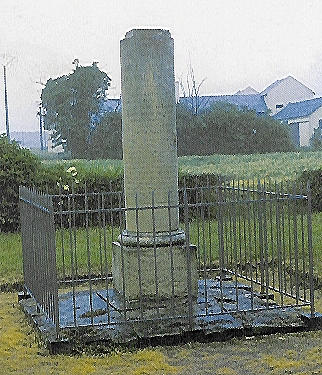|
The Battle of Val-es-Dunes, Normandy, France 1047
|
Date: Thu, 06 May 1999 11:59:30 +0100 From: Niven Sinclair <niven@niven.co.uk> This was not the first time the Sinclairs had fought against William 'the [future] Conqueror' because at the Battle of Val-es-dunes in 1047 Walderne and Hamon St Clair with other Norman knights had fought against William who was, at that time, known as 'the Bastard' as he was illegitimate. Nevertheless, his father, Robert 'the Devil' wished William to succeed him as the Duke of Normandy. The Sinclairs, believing that they were the legitimate line, contested this. They lost the battle but it was a closely run thing. Incidentally, Hubert St Clair, the brother of Walderne and Hamon, fought on the side of William so it was a case of brother against brother, Norman against Norman. Because Hubert had been on the victorious sides his sons were rewarded with great tracts of land in Essex, Kent, Somerset, Cornwall and Devon after William's victory at Hastings. Strangely, the sons of Hamon and Walderne (who had both been killed at Val-es-dunes) were also at Hastings. When the chips were down the Normans united. Altogether, there were nine St Clair Knights at Hastings - the largest single contingent in William's army. Within three generations of the Conquest, we find the St Clairs in 43 English counties and in Wales. |
From: "Spirit One Email" <laurel@spiritone.com>
When Duke Robert of Normandy died on a pilgrimage to the Holy Land in 1035, his 8-yr. old son William (the future Conqueror) became a ward of his natural liege lord, King Henry I of France. There followed much strife as many heirs and unrelated counts attempted to take over as the Duke of Normandy. Throughout the minority of William, the king claimed and maintained direct rights over the duchy.
In the late fall of 1046 the rebellion focused on the assassination of the young Duke, himself and replacing him with Guy of Burgundy. A group of lords from the district of Singlis, situated between Caen and Falaise added their support. We find among this group Haimo dentatus (the teeth) the son of Maugar who was the son of Richard I. Haimo was the older brother of the Walderne/Walter, apparent ancestor to the St. Clair/Sinclair line to Scotland and England.
An attempt to capture and murder William at Valgnes failed when he was warned of the danger mading a hurried escape by night and crossed the estuary of the Vire at low tide. By morning he was at Ryes, where he received assistance from Hubert Earl of Rye s/o Mauger, and brother of our Walderne.
William then hurried to Poissy where King Henry was and threw himself before him and claimed as a faithful vassal the help of his liege lord. Henry felt that he was involved in this threat to his over-lordship of this fief and that this rebellion was also directed toward himself. So early in 1047 he arrived in Normandy at the head of an army to rescue Duke William from the rebels.
 The army met the rebels on the featureless plain of Val-es-Dunes.
There are few details about the battle that consisted of isolated cavalry
encounters. There was no use of supporting arms, archers or long-range
weapons. Infantry was negligible. The King and Duke appear to have been
confident from the beginning because of their superior number of knights.
The insurgents were poorly organized and defections began. Early in the
combat, King Henry was unhorsed by Haimo dentatus. But before he could
press for the kill, he was killed. It is also believed that Walderne of St.
Clair was also killed at this battle. As the great slaughter began, the
enemies were seized with panic and fled, trampling to death their comrade,
only to drown in the Orne River as they tried frantically to cross it.
The army met the rebels on the featureless plain of Val-es-Dunes.
There are few details about the battle that consisted of isolated cavalry
encounters. There was no use of supporting arms, archers or long-range
weapons. Infantry was negligible. The King and Duke appear to have been
confident from the beginning because of their superior number of knights.
The insurgents were poorly organized and defections began. Early in the
combat, King Henry was unhorsed by Haimo dentatus. But before he could
press for the kill, he was killed. It is also believed that Walderne of St.
Clair was also killed at this battle. As the great slaughter began, the
enemies were seized with panic and fled, trampling to death their comrade,
only to drown in the Orne River as they tried frantically to cross it.
The Battle of Val-es-Dunes was a decisive event which forced William's seditious uncles, Archbishop Maugar the Younger (the nephew of our Mauger), and William Count of Arques to decrease their attacks for awhile. William had proved a valiant fighter and more were drawn to his support. The significance of this battle for the St. Clairs/Sinclairs is that it ended any hope that a St. Clair would become the 8th Duke of Normandy. And if he were inclined to conquer England also, henceforth all their monarchs would have claimed descent from either Haimo or Walderne St. Clair instead of their cousin, Duke William the Conqueror.
Sources: William the Conqueror by David C. Douglas; The History of the Sinclair Family in Europe and America by Leonard Morrison.
The name is also sometimes spelled Vales Dunes or Val-aux-Dunes.
Last changed: 00/11/27 12:40:25
